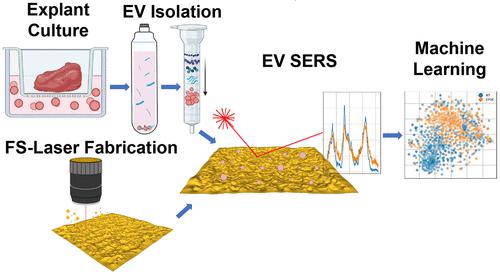Our official English website, www.x-mol.net, welcomes your
feedback! (Note: you will need to create a separate account there.)
Classification of Preeclamptic Placental Extracellular Vesicles Using Femtosecond Laser Fabricated Nanoplasmonic Sensors
ACS Sensors ( IF 8.2 ) Pub Date : 2022-06-06 , DOI: 10.1021/acssensors.2c00378 Mohammadrahim Kazemzadeh 1, 2 , Miguel Martinez-Calderon 3 , Song Y Paek 4 , MoiMoi Lowe 3 , Claude Aguergaray 2, 3 , Weiliang Xu 1, 2 , Lawrence W Chamley 4, 5 , Neil G R Broderick 2, 3 , Colin L Hisey 4, 5, 6
ACS Sensors ( IF 8.2 ) Pub Date : 2022-06-06 , DOI: 10.1021/acssensors.2c00378 Mohammadrahim Kazemzadeh 1, 2 , Miguel Martinez-Calderon 3 , Song Y Paek 4 , MoiMoi Lowe 3 , Claude Aguergaray 2, 3 , Weiliang Xu 1, 2 , Lawrence W Chamley 4, 5 , Neil G R Broderick 2, 3 , Colin L Hisey 4, 5, 6
Affiliation

|
Placental extracellular vesicles (EVs) play an essential role in pregnancy by protecting and transporting diverse biomolecules that aid in fetomaternal communication. However, in preeclampsia, they have also been implicated in contributing to disease progression. Despite their potential clinical value, current technologies cannot provide a rapid and effective means of differentiating between healthy and diseased placental EVs. To address this, a fabrication process called laser-induced nanostructuring of SERS-active thin films (LINST) was developed to produce scalable nanoplasmonic substrates that provide exceptional Raman signal enhancement and allow the biochemical fingerprinting of EVs. After validating the performance of LINST substrates with chemical standards, placental EVs from tissue explant cultures were characterized, demonstrating that preeclamptic and normotensive placental EVs have classifiably distinct Raman spectra following the application of advanced machine learning algorithms. Given the abundance of placental EVs in maternal circulation, these findings encourage immediate exploration of surface-enhanced Raman spectroscopy (SERS) of EVs as a promising method for preeclampsia liquid biopsies, while this novel fabrication process will provide a versatile and scalable substrate for many other SERS applications.
中文翻译:

使用飞秒激光制造的纳米等离子体传感器对先兆子痫胎盘细胞外囊泡进行分类
胎盘细胞外囊泡 (EV) 通过保护和运输有助于母体交流的多种生物分子,在妊娠中发挥重要作用。然而,在先兆子痫中,它们也与疾病进展有关。尽管它们具有潜在的临床价值,但目前的技术无法提供一种快速有效的方法来区分健康和患病的胎盘 EV。为了解决这个问题,开发了一种称为激光诱导 SERS 活性薄膜纳米结构 (LINST) 的制造工艺,以生产可扩展的纳米等离子体基板,该基板提供出色的拉曼信号增强并允许对 EV 进行生化指纹识别。在用化学标准验证 LINST 底物的性能后,对来自组织外植体培养物的胎盘 EV 进行了表征,证明在应用先进的机器学习算法后,先兆子痫和血压正常的胎盘 EV 具有明显不同的拉曼光谱。鉴于母体循环中有大量的胎盘 EV,这些发现鼓励立即探索 EV 的表面增强拉曼光谱 (SERS) 作为先兆子痫液体活检的一种有前途的方法,而这种新颖的制造工艺将为许多其他方法提供通用且可扩展的基板SERS 应用。
更新日期:2022-06-06
中文翻译:

使用飞秒激光制造的纳米等离子体传感器对先兆子痫胎盘细胞外囊泡进行分类
胎盘细胞外囊泡 (EV) 通过保护和运输有助于母体交流的多种生物分子,在妊娠中发挥重要作用。然而,在先兆子痫中,它们也与疾病进展有关。尽管它们具有潜在的临床价值,但目前的技术无法提供一种快速有效的方法来区分健康和患病的胎盘 EV。为了解决这个问题,开发了一种称为激光诱导 SERS 活性薄膜纳米结构 (LINST) 的制造工艺,以生产可扩展的纳米等离子体基板,该基板提供出色的拉曼信号增强并允许对 EV 进行生化指纹识别。在用化学标准验证 LINST 底物的性能后,对来自组织外植体培养物的胎盘 EV 进行了表征,证明在应用先进的机器学习算法后,先兆子痫和血压正常的胎盘 EV 具有明显不同的拉曼光谱。鉴于母体循环中有大量的胎盘 EV,这些发现鼓励立即探索 EV 的表面增强拉曼光谱 (SERS) 作为先兆子痫液体活检的一种有前途的方法,而这种新颖的制造工艺将为许多其他方法提供通用且可扩展的基板SERS 应用。











































 京公网安备 11010802027423号
京公网安备 11010802027423号